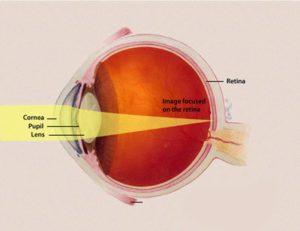Blog
Retinitis Pigmentosa

What is retinitis pigmentosa?
Retinitis pigmentosa is an inherited disorder in which cells in the retina break down and lose function. It is rare, affecting just one in 4,000 people worldwide.
What causes retinitis pigmentosa?
Retinitis pigmentosa results when there are mutations in certain genes that can be passed on in families. More than 50 genes have been identified that play a role in the disease. They carry the instructions for making proteins that retinal cells need. When these genes are altered, cells in the retina may lose their function. The cells that are affected are called photoreceptors and include rods and cones. Rods help us see in dim and dark lighting, while cones help us see detail and color.
What are the symptoms of retinitis pigmentosa?
The symptoms of retinitis pigmentosa vary from person to person, but eventually most people lose most of their sight. In the early stages of the disorder, rods are more seriously affected than cones, resulting in night blindness and gradual loss of the visual field (what you can see without moving your eyes). In the later stages of retinitis pigmentosa, cones begin to die, causing tunnel vision and making daily tasks difficult, such as reading, driving, walking, or recognizing objects and faces. In addition:
- It can take a long time to adjust to changes in lighting.
- Bright lights may be uncomfortable.
- Children who have retinitis pigmentosa may have trouble getting around in the dark.
How is retinitis pigmentosa diagnosed?
An eye care professional can tell if your symptoms are due to retinitis pigmentosa or another cause by performing a comprehensive dilated eye exam, which includes examination of the retina. In retinitis pigmentosa, there are abnormal deposits of dark pigment streaking the retina. You may also have:
- Electroretinography (ERG). This test measures the electrical activity of photoreceptors. There is typically decreased electrical activity in retinitis pigmentosa.
- Visual field testing to determine the extent of vision loss.
- Genetic testing to identify the mutation(s) which may be causing retinitis pigmentosa, and counseling to help you understand the results. If you have a mutation, you can discuss whether other family members should have genetic testing as well.
Can retinitis pigmentosa be treated?
There is no standard cure for retinitis pigmentosa, but research has suggested that certain approaches may be useful:
- High doses of vitamin A (as much as 15,000 IU daily) have been shown to slow retinitis pigmentosa progression in some adults. Talk with your eye care professional to find out if this is an option for you.
- Retinal implant or “bionic eye.” The Argus® II Retinal Prosthesis System is a surgically implanted light-sensing device that electrically stimulates the retina. You would wear a special pair of glasses with a camera that wirelessly transmits signals to the device, which are then relayed to the brain to process images. This innovative retinal implant does not help you achieve normal vision, but does restore some sight to people with severe to profound retinitis pigmentosa.
- Research is under way to explore gene therapy and stem cell treatments for retinitis pigmentosa.
How can I cope with retinitis pigmentosa?
Start by assembling a vision rehabilitation team, which may include an ophthalmologist, low vision specialist, occupational therapist, rehabilitation teacher, orientation and mobility specialist, social worker, and/or counselor. Your vision rehabilitation team can connect you with resources and teach you how to use tools to maximize the use of your remaining vision, such as:
- Optical low vision aids like magnifiers and telescopes to help you read and see objects more easily.
- Non-optical devices such as talking watches, timers, blood sugar machines, and blood pressure cuffs; large-print reading materials; telephones, watches, remote controls, and thermostats with large digits and high-contrast colors; and helpful tools such as needle threaders, tactile labels, and magnifying mirrors.
- Electronic devices including video magnifiers; audio books; electronic books, smartphones, and tablets that enable you to change the font size; low vision apps; and computers that can read aloud or magnify what is on the screen.
If you have a child with retinitis pigmentosa, meet with his or her school administrators and teachers to ensure that necessary accommodations are made to help your child learn. Also be sure to have your child’s vision assessed regularly to see how the disorder is progressing and to determine if other adjustments need to be made.